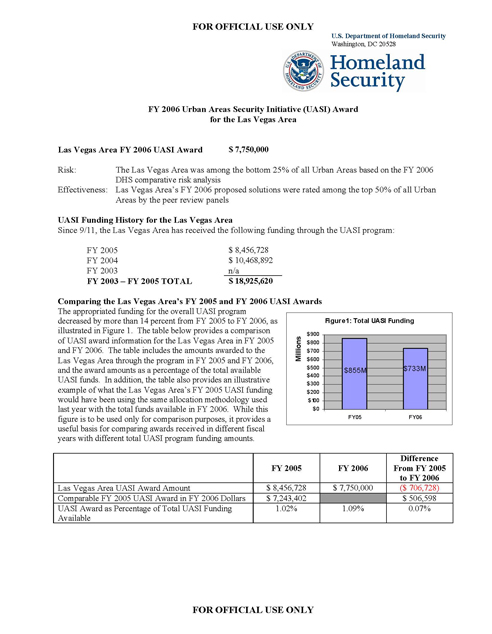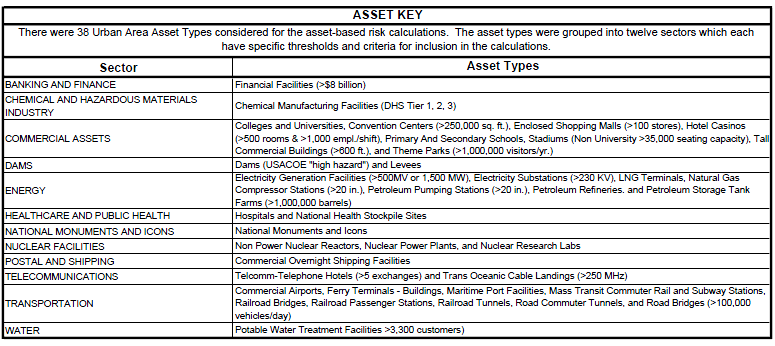Urban Areas Security Initiative (UASI) Grant
- 8 pages
- For Official Use Only
- May 30, 2006
Las Vegas Area FY 2006 UASI Award
$ 7,750,000
Risk: The Las Vegas Area was among the bottom 25% of all Urban Areas based on the FY 2006 DHS comparative risk analysis
Effectiveness: Las Vegas Area’s FY 2006 proposed solutions were rated among the top 50% of all Urban Areas by the peer review panels
UASI Funding History for the Las Vegas Area Since 9/11, the Las Vegas Area has received the following funding through the UASI program:
FY 2005 $ 8,456,728
FY 2004 $ 10,468,892
FY 2003 n/aFY 2003 – FY 2005 TOTAL $ 18,925,620
Comparing the Las Vegas Area’s FY 2005 and FY 2006 UASIOverview
As part of this risk-based approach to preparedness, DHS’ Fiscal Year 2006 (FY06) risk methodology represents a major step forward in the analysis of the risk of terrorism, resulting in the most accurate estimation to-date of the relative risk faced by our Nation’s communities. In response to State and local partner feedback, the FY06 methodology incorporates a number of significant enhancements over previous years’ analyses, including:
• Incorporation of strategic threat analysis from the Intelligence Community
• Improved attribution of threat and law enforcement activity data
• Greater depth and breadth in critical infrastructure and key asset data
• Inclusion of populated areas outside official city limits to encourage regionalization
• Incorporation of transient populations, such as tourists and commutersDHS defines risk by three principal variables: threat, or the likelihood of a type of attack that might be attempted, vulnerability, or the likelihood that an attacker would succeed with a particular attack type, and consequence, or the potential impact of a particular attack. The risk model used to allocate HSGP funds includes both asset-based and geographically-based terrorist risk calculations. DHS combines these complementary risk calculations to produce an estimate of the relative risk of terrorism faced by a given area. Asset-based risk – The asset-based approach uses strategic threat estimates from the Intelligence Community of an adversary’s intent and capability to attack different types of assets (such as chemical plants, stadiums, and commercial airports) using different attack methods. DHS analyzes the vulnerability of each asset type relative to each attack method to determine the form of attack most likely to be successful.
Additionally, DHS estimates the consequences that successful attacks would have on each asset type, including human health, economic, strategic mission, and psychological impacts. This analysis yields a relative risk estimate for each asset type, which DHS applies to a given geographic area, based on the number of each asset type present within that area. Geographically-based risk – The geographic-based approach allows DHS to consider general characteristics of a geographic area mostly independent of the assets that exist within that area. First, DHS evaluates reported threats, law enforcement activity (using Federal Bureau of Investigation and Immigration and Customs Enforcement terrorism case data), and suspicious incidents reported during the evaluation period. Next, DHS considers vulnerability factors for each geographic area, such as the area’s proximity to international borders. Lastly, DHS estimates the potential consequences of an attack on that area, including human health (e.g., population, population density, transient populations), economy (e.g., percentage of Gross Domestic Product, total agriculture sales, international cargo value), strategic mission (e.g., defense industrial base), and psychological impacts.
Las Vegas Area Results
• In evaluating the relative risk to the Las Vegas Area, DHS looked at data for the cities of Las Vegas and North Las Vegas, and a ten mile buffer extending from the limits of those cities. DHS then evaluated both the risk to individual assets residing within that combined area, and the risk to the geographic area itself, the sum of which placed the Urban Area into the top 25%, top 50%, bottom 50%, or bottom 25% of the 46 eligible Urban Areas.
• A total of 746 assets in eight critical infrastructure sectors met the criteria for consideration in the analysis; for the Las Vegas Area, the largest concentration of these was Commercial Assets. When the asset-based risk analysis was applied to these assets, the Las Vegas Area fell in the bottom 25% of the eligible Urban Areas, meaning that the risk associated with individual assets in the Las Vegas Area was lower than at least threequarters of the eligible Urban Areas.
• In the geographic-based risk analysis, the Las Vegas Area fell in the bottom 50% of the eligible Urban Areas, indicating that it had a lower level of risk associated with reported threat and investigative activity, resident and visitor populations, and other geographic criteria than at least half of the eligible Urban Areas.
• When the asset-based and geographic-based risk data for the Las Vegas Area was aggregated, it placed it in the bottom 25% of all eligible Urban Areas.
• Based on the DHS comparative risk analysis, the Las Vegas Area did not place in the top 35 areas.
• However, the Las Vegas Area was extended an additional year of eligibility to participate in the UASI program and was eligible to apply for continuity and sustainment funding.
…



